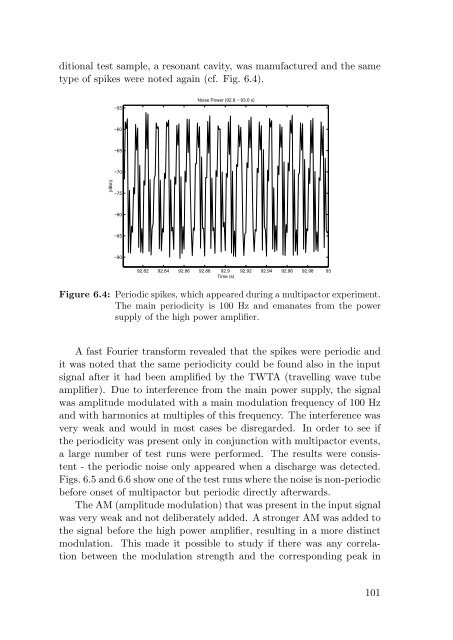Multipactor in Low Pressure Gas and in ... - of Richard Udiljak
Multipactor in Low Pressure Gas and in ... - of Richard Udiljak
Multipactor in Low Pressure Gas and in ... - of Richard Udiljak
You also want an ePaper? Increase the reach of your titles
YUMPU automatically turns print PDFs into web optimized ePapers that Google loves.
ditional test sample, a resonant cavity, was manufactured <strong>and</strong> the same<br />
type <strong>of</strong> spikes were noted aga<strong>in</strong> (cf. Fig. 6.4).<br />
(dBm)<br />
−55<br />
−60<br />
−65<br />
−70<br />
−75<br />
−80<br />
−85<br />
−90<br />
Noise Power (92.8 − 93.0 s)<br />
92.82 92.84 92.86 92.88 92.9<br />
Time (s)<br />
92.92 92.94 92.96 92.98 93<br />
Figure 6.4: Periodic spikes, which appeared dur<strong>in</strong>g a multipactor experiment.<br />
The ma<strong>in</strong> periodicity is 100 Hz <strong>and</strong> emanates from the power<br />
supply <strong>of</strong> the high power amplifier.<br />
A fast Fourier transform revealed that the spikes were periodic <strong>and</strong><br />
it was noted that the same periodicity could be found also <strong>in</strong> the <strong>in</strong>put<br />
signal after it had been amplified by the TWTA (travell<strong>in</strong>g wave tube<br />
amplifier). Due to <strong>in</strong>terference from the ma<strong>in</strong> power supply, the signal<br />
was amplitude modulated with a ma<strong>in</strong> modulation frequency <strong>of</strong> 100 Hz<br />
<strong>and</strong> with harmonics at multiples <strong>of</strong> this frequency. The <strong>in</strong>terference was<br />
very weak <strong>and</strong> would <strong>in</strong> most cases be disregarded. In order to see if<br />
the periodicity was present only <strong>in</strong> conjunction with multipactor events,<br />
a large number <strong>of</strong> test runs were performed. The results were consistent<br />
- the periodic noise only appeared when a discharge was detected.<br />
Figs. 6.5 <strong>and</strong> 6.6 show one <strong>of</strong> the test runs where the noise is non-periodic<br />
before onset <strong>of</strong> multipactor but periodic directly afterwards.<br />
The AM (amplitude modulation) that was present <strong>in</strong> the <strong>in</strong>put signal<br />
was very weak <strong>and</strong> not deliberately added. A stronger AM was added to<br />
the signal before the high power amplifier, result<strong>in</strong>g <strong>in</strong> a more dist<strong>in</strong>ct<br />
modulation. This made it possible to study if there was any correlation<br />
between the modulation strength <strong>and</strong> the correspond<strong>in</strong>g peak <strong>in</strong><br />
101


